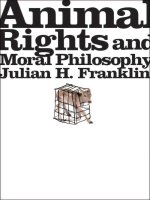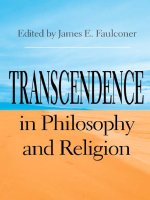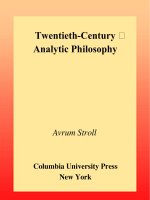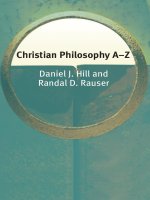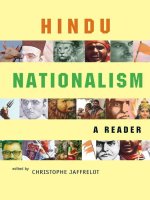columbia university press twentieth-century analytic philosophy jul 2000
Bạn đang xem bản rút gọn của tài liệu. Xem và tải ngay bản đầy đủ của tài liệu tại đây (1.05 MB, 315 trang )
Twentieth-Century
Analytic Philosophy
Avrum Stroll
Columbia University Press
New York
Twentieth-Century Analytic Philosophy
C
Columbia University Press
New York
Avrum Stroll
Twentieth-Century
ANALYTIC P H I L OSOPHY
Columbia University Press
Publishers Since 1893
New York Chichester, West Sussex
Copyright © 2000 Columbia University Press
All rights reserved
Library of Congress Cataloging-in-Publication Data
Stroll, Avrum, 1921–
Twentieth-century analytic philosophy / Avrum Stroll.
p. cm.
Includes bibliographical references and index.
ISBN 0–231–11220–3 (alk. paper)
1. Analysis (Philosophy)—History. I. Title.
B808.5 .S77 2000
146’.4’0904—dc21 99–087366
Casebound editions of Columbia University Press books are printed on
permanent and durable acid-free paper.
Printed in the United States of America
c 10 9 8 7 6 5 4 3 2 1
For Mary
Acknowledgments ix
one
The Solera System 1
two Philosophical Logic 11
three Logical Positivism and the Tractatus 45
four G. E. Moore: A Ton of Bricks 87
five Wittgenstein’s Later Philosophy: “The Stream of Life” 113
six Ryle and Austin: The Golden Age of Oxford Philosophy 146
seven W. V. O. Quine 181
eight Direct Reference Theories 211
nine Today and Tomorrow 246
References 271
Index 281
Given the span of more than a hundred years that this study covers, and
the complexity of much of the material, I would have found it impossible
to write this book without abundant expert assistance. I therefore wish to
thank Zeno Vendler, Robert Rowan, Henry Alexander, Pieranna Garavaso,
A. P. Martinich, and John Collins for their invaluable comments. Each of
them read the entire manuscript and, mirabile dictu, presented me with
written criticisms, as well as detailed recommendations for improvement.
My appreciation for the labor they expended is boundless. I also owe a debt
of gratitude to the editor of the Journal of Philosophy, who allowed me to
include in this work part of an essay, “Proper Names, Names, and Fictive
Objects,” that I published in the Journal in 1998. I owe a similar debt to an
editor at MIT Press for permission to use part of a chapter from my
Sketches of Landscapes: Philosophy by Example (1998). These materials
appear in the last sections of chapter 8. With those exceptions, the book
contains only new writings.
I wrote much of the manuscript during two stays at the American Acad-
emy in Rome, and without the hospitality and generosity of the then direc-
tor, Caroline Bruzelius, and the assistant director, Pina Pasquantonio, it
would have taken me much longer to complete this work. Finally, no
expression of thanks will do justice to the acute observations on the text
made by my wife, Mary. Her careful reading of the manuscript greatly
improved its style, organization, level of argument, and content. That she
took so much time away from her own current research on twelfth-century
papal politics is indeed an act of supererogation. For her help, and, of
course, for other reasons, I dedicate this book to her.
Chapter One
The Solera System
The rapidity with which major movements suddenly appear, flourish, lose
their momentum, become senescent, and eventually vanish marks the his-
tory of twentieth-century analytic philosophy. Examples include idealism in
its absolutist and subjectivist variants, sense-data theory, logical atomism,
neutral monism, and logical positivism. These defunct “isms,” and their liv-
ing congeners, such as “reductionism,” “pragmatism,” and “naturalism,” form
the subject matter of this study and will be explained for the general reader in
due course. There are, of course, exceptions to the pattern of birth, flowering,
and decline. In ontology various forms of materialism continue to enjoy
widespread support, and naturalized epistemology—developed by W. V. O.
Quine and expanded by his followers—shows no signs of abatement.
Indeed, if anything, the prestige of science has intensified in the twen-
tieth century. Scientism, the doctrine that only the methods of the natural
sciences give rise to knowledge, is today widely espoused in epistemology,
metaphysics, philosophy of language, and philosophy of mind. In 1918 in
Allgemeine Erkenntnislehre Moritz Schlick, the founder of the Vienna Cir-
cle, formulated the doctrine in this way: “Since science in principle can
say all that can be said there is no unanswerable question left.” Patricia S.
Churchland’s Neurophilosophy (1986) contains a later expression of the
same position: “In the idealized long run, the completed science is a true
description of reality: there is no other Truth and no other Reality.”
Contemporary philosophers have reacted to the impact of science in
three different ways, two of which are forms of scientism. The more radical
of the two asserts that if philosophy has a function it must be something
other than trying to give a true account of the world, because science pre-
empts that prerogative. In the Tractatus, for example, Ludwig Wittgenstein
writes: “Philosophy is not one of the natural sciences. . . . The result of phi-
2
The Solera System
losophy is not a number of ‘philosophical propositions’, but to make propo-
sitions clear.” A variant of this view is to hold that philosophy should deal
with normative or value questions, as opposed to science, which is a wholly
descriptive, fact-finding activity. A second less radical reaction is to main-
tain that philosophy, when correctly done, is an extension of science. It is
contended that both disciplines are committed to the same standards of
evidence and logical cogency but that their subject matters are different.
According to Quine, there is a division of labor among investigators. For
example, professional scientists use numbers in constructing theories, and
philosophers analyze the concept of number as it is used in such contexts.
More generally, some scientistically oriented philosophers hold that the
task of philosophy consists in analyzing the foundations of knowledge,
including the main concepts of science. Finally, a variety of approaches
reject scientism and in different ways defend the autonomy of philosophy;
their proponents hold that philosophy has a descriptive function and can
arrive at nonscientific truths about reality. G. E. Moore, Ludwig Wittgen-
stein, J. L. Austin, O. K. Bouwsma, Norman Malcolm, and Gilbert Ryle,
inter alios, can be assigned to this last category.
The question about the relationship between science and philosophy
leads to another major contrast. This is the issue, much debated in the twen-
tieth century, of whether philosophy should be dedicated to the construction
of theories about the world and its various features. The controversy cuts
across the scientism/autonomy distinction at an angle, since many commit-
ted to scientism as well as many of their opponents (such as traditional meta-
physicians) feel that philosophy should engage in theory construction. There
are also those who espouse and those who reject forms of scientism yet deny
that the business of philosophy is theorizing. Wittgenstein is perhaps the most
famous example of a philosopher who espoused scientism in his early work,
the Tractatus of 1922, and disavowed it in his later writings, such as the Philo-
sophical Investigations, published in 1953. Nevertheless, from beginning to
end he consistently rejected the notion that the aim of philosophy is theory
construction. In the Tractatus, for example, he states: “Philosophy is not a
theory but an activity” (4.112). Virtually the same words occur in the Investi-
gations: “It was true to say that our considerations could not be scientific
ones. . . . And we may not advance any kind of theory. . . . We must do away
with all explanation, and description alone must take its place” (1958:109).
These two distinctions (scientism versus autonomy, and theorizing ver-
sus nontheorizing) raise a profound problem that we shall address at length
The Solera System
3
in this study. What is philosophy? What is (are) its task (tasks)? What kind
of information, illumination, and understanding is it supposed to provide if
it is not one of the natural sciences? Within the so-called analytic move-
ment this is one of the sharpest issues that divides practitioners about the
point and purpose of doing philosophy.
One thing we have surely learned from studying the preceding period is
that contemporary analytic philosophy is intimately tied to its history. In this
respect it is less like science and more like history and literature, although
there are important differences even here. But the contrast with science is
more striking. Why this is so is complicated. Partly it is due to the difference
between empirical and conceptual activities. Aristotle’s cosmological theo-
ries are not of current interest to most scientists. Insofar as his problems were
susceptible to experimental treatment, they have been solved. Insofar as they
were metaphysical, they remain immune to scientific analysis and indeed
may resist solution altogether. The early discoveries of Galileo and Newton
are no longer in the forefront of scientific attention because they have been
absorbed into routine investigative procedure. When such absorption
occurs, science moves on without much memory of its predecessors.
But this is not true of philosophy. Plato and Aristotle have never died,
even though their ideas have become part and parcel of present practice.
We still read Thucydides and Gibbon on the use and abuse of political
power and Shakespeare and Jane Austen for their penetrating insights into
human character. Despite frequent references to “scientific philosophy”
today, there is no doubt that philosophy is essentially a humanistic activity.
And this is shown by its ties to the past. Even though most analytic philoso-
phers are not exegetes of ancient texts, the problems posed by venerable
thinkers are still as vivid now as they were centuries ago. Many issues we
presently deal with first surfaced eons ago: How it is possible to speak
meaningfully/truly about the nonexistent? How with consistency can one
deny that something exists? How is it possible for two true identity sen-
tences to differ in meaning? Is existence a property? Yet despite their older
origins, all these questions have been of pressing centrality in the work of
Gottlob Frege, Bertrand Russell, Saul Kripke, and Quine, to name a few.
Shall we then conclude that no progress has been made in this discipline?
I do not think we should. But if there is progress, it cannot be identical
with that made in science, which often achieves definite solutions. Yet phi-
losophy exhibits something like advancement: there are improvements in
the techniques used and new schemes for resolving traditional issues.
4
The Solera System
Thus, in a sense difficult to articulate, the contemporary turf is both famil-
iar and alien; we seem to recognize it as terrain we have traversed in the
past, and yet it somehow now looks quite different.
It is thus difficult to answer the question about progress without taking
account of the role that the past plays in contemporary analytic philosophy.
In trying to find a figure of speech that would provide a picture of this com-
plex relationship, I originally thought I would call this chapter “New Wine
in Old Wineskins.” The new wine would be the philosophy I will be
describing in this book, and the old wineskins would be the tradition that,
stemming from the Greeks, often sets the problems and sometimes the out-
lines of the solutions to them. But the analogy is not quite right. Contem-
porary philosophy is perhaps a kind of new wine, but traditional philoso-
phy is not an old wineskin. You can drink wine but not a wineskin. We
need a conceit in which traditional philosophy is like old wine that inter-
mingles with a new vintage. I suggest a metaphor that captures this rela-
tionship. Sherry makers call it the “solera system.”
In his Encyclopedia of Wines and Spirits, Alexis Lichine describes it in
these words:
The most interesting thing about Sherry (apart from the mysterious
flor) is the peculiar system by which it is kept at its best. A very old, very
fine Sherry has the power to educate and improve a younger one.
Because of this, the old wines are kept in the oldest barrels of what the
growers call a solera. This is a series of casks graduated by age. A series
is made up of identical butts. The oldest class in a solera is the one
called the Solera. The next oldest is the first Criadera, the next the sec-
ond Criadera, and so on. When the wine is drawn from the Solera, it is
drawn in equal quantity from each butt. Then starts a progressive sys-
tem by which the Solera is refilled by the first Criadera and that in turn
by the second Criadera, etc. The magic result of this system is that the
oldest casks remain eternally the same in quality. A cask of 1888, for
instance, may retain hardly a spoonful of its original vintage; but each
replacement poured back into it over the years will have been educated
to be 1888, and replacements still to come will be schooled to the same
standard. By this system, it is possible not only to preserve the same
quality and character of wine over the years, but also, by constantly
refreshing the Fino types with younger wine, to keep these from losing
their freshness.
(1971:492)
The Solera System
5
In this system of pipes and barrels we find a way of describing the rela-
tionship between traditional and contemporary philosophy. Borrowing
Lichine’s phrase, we can say that old philosophy has the power to educate
and improve new philosophy. And new philosophy not only preserves the
quality and character of old philosophy but has the capacity to refresh it.
Intermingling, preservation, and refreshment are thus the characteristics
that define the relationship between present philosophy and its history. But
now the question is whether the solera metaphor fits the facts. Is twentieth-
century analytic philosophy like new wine? Or is it like old wine that has
lost its freshness?
The issue is compounded by the fact that it is difficult to give a pre-
cise definition of “analytic philosophy” since it is not so much a specific
doctrine as a loose concatenation of approaches to problems. The cen-
tury begins with a book, G. E. Moore’s Principia Ethica (1903), that
emphasizes the importance of “analysis” in attempting to understand the
nature of moral deliberation. Moore argues that the predicate “good,”
which defines the sphere of ethics, is “simple, unanalyzable, indefin-
able” (p. 37). His contention is that many of the difficulties in ethics, and
indeed in philosophy generally, arise from an “attempt to answer ques-
tions, without first discovering precisely what question it is which you
desire to answer.” Questions thus require “analysis” to unpack them and
to know what they mean. Moore’s monograph unquestionably sensitized
his contemporaries and nearly all his successors to the importance of
becoming clear about the questions they asked and the kinds of answers
that would be appropriate.
But it would be a misreading of history to think that the idea of philo-
sophical analysis begins with Moore. There is a much longer tradition of
analysis whose lineage can be traced to the ancient Greeks. Socrates, for
instance, can be construed as trying to capture the ordinary meaning of the
concept of justice in Books I and II of the Republic. The dialectical
method he uses, which consists of proposed definitions and counterexam-
ples to them, with a sustained effort to arrive at the essence of justice, is not
much different from Moore’s approach in Principia Ethica with respect to
the notion of “good.” Similar remarks apply to Aristotle’s characterization
of truth in the Metaphysics, which prefigures Alfred Tarski’s semantic con-
ception in Der Wahreitsbegriff in den formalisierten Sprachen of 1935.
There is clearly an analytic streak embedded in David Hume’s voluminous
writings, as exemplified by his explication of the notion of causation. It is
6
The Solera System
thus plausible to argue that something like analysis has always been part
and parcel of philosophical practice.
Still, even today there is no consensus on what analysis is. The history
of the topic is replete with suggested definitions. In “Logical Atomism,”
published in 1924, Bertrand Russell writes: “The business of philosophy, as
I conceive it, is essentially that of logical analysis, followed by logical syn-
thesis. . . . The most important part [of philosophy] consists in criticizing
and clarifying notions which are apt to be regarded as fundamental and
accepted uncritically” (1956:341). C. D. Broad regarded analytic philoso-
phy as a kind of science: “Thus there is both need and room for a science
which shall try to analyze and define the concepts which are used in daily
life and in the specific sciences” (1924:78–79). In the Origins of Analytical
Philosophy (1993), Michael Dummett proffers a two-part characterization:
“What distinguishes analytical philosophy, in its diverse manifestations,
from other schools is the belief, first, that a philosophical account of
thought can be attained through a philosophical account of language, and,
secondly, that a comprehensive account can only be so attained” (p. 4).
The two most extensive, recent discussions of this notion appear in
P. M. S. Hacker’s Wittgenstein’s Place in Twentieth-Century Analytic Phi-
losophy (1996) and in Hans Sluga’s critical notice of Hacker’s book, “What
Has History to Do with Me? Wittgenstein and Analytic Philosophy,” in
Inquiry (1998). Hacker gives a brief survey of the modern use of this con-
cept and draws several illuminating distinctions, such as those between log-
ical and conceptual analysis, and reductive and constructive analysis. His
ultimate decision is to take the term “analysis” to “mean what it appears to
mean, namely the decomposition of something into its constituents.” As he
explains:
Chemical analysis displays the composition of chemical compounds
from their constituent chemical elements; microphysical analysis pene-
trates to the subatomic composition of matter, disclosing the ultimate
elements of which all substance is composed. Philosophical analysis
harboured similar ambitions within the domain of ideas or concepts
which are the concern of philosophy. Accordingly, I take the endeav-
ours of the classical British empiricists to be a psychological form of
analytic philosophy, for they sought to analyse what they thought of as
complex ideas into their simple constituents. This method of analysis,
they believed, would not only clarify problematic, complex ideas, but
The Solera System
7
also shed light upon the origins of our ideas, as well as upon the sources
and limits of human knowledge. Taking ‘analysis’ decompositionally,
twentieth-century analytic philosophy is distinguished in its origins by
its non-psychological orientation.
(Hacker 1998:3–4)
Sluga’s essay opens with a lengthy discussion of what might be meant
by “analytic philosophy.” After a careful evaluation of various historical
options, he concludes as follows:
The outcome of all this is that it may be hopeless to try to determine the
essence of analytic philosophy, that analytic philosophy is to be charac-
terized in terms of overlapping circles of family resemblances and of
causal relations of “influence” that extend in all directions and cer-
tainly far beyond the boundaries we hope to draw. So our question
should not be: what precise property do all analytic philosophers share?
But: how can one draw the boundaries of analytic philosophy most nat-
urally and most usefully and to what uses are we putting the term when
we draw them in one way rather than another?
(p. 107)
I think Sluga is right in saying “it may be hopeless to try to determine the
essence of analytic philosophy.” Nearly every proposed definition has been
challenged by some scholar. It has been denied that analysis is a science,
that the notions being analyzed are those that are accepted uncritically, that
analysis seeks to give a philosophical account of thought, that what is being
sought is a comprehensive account of anything, or that “analysis,” as Hacker
contends, is always the decomposition of a concept into its elements. On
this last point J. L. Austin’s account in “Three Ways of Spilling Ink” (1970b)
of the difference between doing something intentionally, deliberately, or on
purpose is an example of the analysis of the concept of responsibility that
does not involve the decomposition of the concept into its constituents.
Such actions are not constituents of responsibility in the way that atoms of
hydrogen and oxygen are constituents of a molecule of water.
Let us accept Sluga’s suggestion, with a slight modification following
Moore, that we are dealing with a family resemblance concept. Many
scholars would agree with Sluga that there is no single feature that charac-
terizes the activities of all those commonly known as analytic philosophers.
Yet most commentators would concur with Moore that, however much the
work of particular practitioners differs, it is directed toward articulating the
8
The Solera System
meaning of certain concepts, such as “knowledge,” “belief,” “truth,” and
“justification.” A guiding assumption for this emphasis is that one cannot
make a judicious assessment of any proposed thesis until one understands
it and its constituent concepts. This is essentially what Moore takes the
function of analysis to be. But there are many different ways of pursuing
such an end, from the strict formal approach of a Frege or a Tarski to the
aphoristic example-oriented technique of the later Wittgenstein. There-
fore, rather than trying to define the concept by looking for some common
feature that all instances of analytic philosophy exhibit, I shall concentrate
on the contributions of a cluster of individuals who are generally regarded
as analytic philosophers. This group includes Gottlob Frege (1848–1925),
Bertrand Russell (1872–1970), G. E. Moore (1873–1958), Ludwig
Wittgenstein (1889–1951), Rudolf Carnap (1891–1970), J. L. Austin
(1911–1960), Gilbert Ryle (1900–1976), and W. V. O. Quine (1908–). Not
all commentators agree on who should be included in such a list. Hacker,
for instance, holds that Quine is not an analytic philosopher. Still, this is a
minority view and most commentators would place Quine in the category.
Most of the major achievements in this field are due to these persons.
They are the initiators of philosophical doctrines, styles, approaches, or
outlooks that become codified and form the rough equivalent of schools.
Such approaches set the fashions and attract numerous followers. Among
such twentieth-century doctrines are logical atomism, commonsense phi-
losophy, pragmatism, ordinary language philosophy, logical positivism,
and the semantic conception of truth. Many of these thinkers have trans-
formed or extended older traditions in new ways (e.g., Quine’s holistic
empiricism), but some (e.g., Austin) have developed new and unique
approaches to philosophical questions. Without a doubt, the most influen-
tial philosopher of the era has been Wittgenstein (1889–1951). His writ-
ings—nearly all published only after his death—dominate the contempo-
rary scene and seem destined to be of central importance in the
foreseeable future. A fruitful way of surveying the period is thus to concen-
trate upon the contributions of this distinguished set of individuals. I shall
do this chronologically. But it should be added that from the 1930s to the
present, other thinkers have also made noteworthy contributions. This
assemblage includes Karl Popper, P. F. Strawson, Roderick Chisholm,
Donald Davidson, David Lewis, Hilary Putnam, Ruth Barcan Marcus,
Paul and Patricia Churchland, John Searle, Zeno Vendler, Tarski,
Bouwsma, Dummett, and Kripke. This list is not complete by any means.
The Solera System
9
Unfortunately, because of space limitations I cannot deal with the work of
each of these persons, though I will deal with some. This study is not so
much a survey of the period as a depiction of what I regard as some main
philosophical ideas in the twentieth century.
The creation of symbolic (or mathematical) logic is perhaps the single
most important development in the century. Apart from its intrinsic inter-
est, and its significance for computer studies and artificial intelligence, it
has exercised an enormous influence on philosophy per se. Though there
are anticipations of this kind of logic among the Stoics, its modern forms
are without exact parallel in Western thought. It quickly became apparent
that an achievement of this order could not easily be ignored, and no mat-
ter how diverse their concerns nearly all analytic philosophers have
acknowledged its importance. This was especially true when the new
logic, with its close affinities to mathematics, was recognized to be funda-
mental to scientific theorizing. Many philosophers regarded the combina-
tion of logic and science as a model that philosophical inquiry should fol-
low. Logical positivism—a doctrine that flourished in the 1930s and
’40s—was a paradigmatic expression of this point of view. In the latter part
of the century, the theories of meaning and reference developed by Car-
nap, Quine, and Putnam have similar antecedents. As we shall see, this
mélange of science and logic dominated American philosophy from the
time of the early pragmatists, such as C. S. Peirce, who was writing at the
beginning of the century, to the present.
But symbolic logic itself, apart from its scientific affiliations, served as a
role model. Many philosophers felt that its criteria of clarity, precision, and
rigor should be the ideals to be emulated in grappling with philosophical
issues. Peter Simons, David Kaplan, Quine, Davidson, Lewis, Marcus, and
Kripke are contemporary well-known representatives of this point of view.
Yet other thinkers, and especially the later Wittgenstein, rejected this
approach, arguing that treating logic as an ideal language, superior to nat-
ural languages, such as English or German, led to paradox and incoher-
ence. Wittgenstein’s later philosophy consisted in developing a unique
method that emphasized the merit of ordinary language in describing the
world. As he says: “What we do is to bring words back from their metaphys-
ical to their everyday use.” In particular, his method avoided the kind of
theorizing and generalization essential to logic.
Despite the manifest influence of symbolic logic, I do not believe that
a command of its technical detail is necessary in order to understand its
10
The Solera System
philosophical impact. An analogy may be helpful here. One can under-
stand a discussion about the effects of the automobile on the atmosphere
without knowing how the internal combustion engine works. In this study,
therefore, I shall make no effort to write the equivalent of a short logic text.
Similar comments are apposite with respect to the discussion of modal
logic in chapter 8.
In those sections of the book where there is a close affinity between
technical logical notions, such as quantification theory, and philosophical
doctrines, such as the theory of descriptions and the direct reference treat-
ment of proper names, it is generally possible to explain the technical logi-
cal notions in ordinary English, and this is the policy I will follow. I thus
believe the reader can understand the philosophical issues without a
grounding in modern logic. With this stipulation in mind, let me now
describe how and why these philosophers responded to the new discipline
in the different ways that they did.
11
Chapter Two
Philosophical Logic
We can begin by describing, in this and the next chapter, two positive reac-
tions to modern logic: the philosophies of logical atomism and logical pos-
itivism. To set the background for the discussion, I shall focus on the work
of Alfred North Whitehead and Bertrand Russell, the authors of Principia
Mathematica (vols. 1–3, 1910–1913). They had two important aims. The
first, following Gottlob Frege, was to show that mathematics is a branch of
logic, in the sense that number theory (arithmetic) can be reduced to
propositions containing only logical concepts, such as constants, quanti-
fiers, variables, and predicates. This was called the “logistic thesis” and we
shall speak about it in a moment. The other was to show that mathematical
logic was an ideal language that could capture, in a purely formal notation,
the large variety of inference patterns and idioms, including different types
of sentences, that are found in ordinary discourse. In doing the latter they
also wished to show how vague expressions could be made more precise
and how sentences susceptible to double readings could be disambiguated
in such a way as clearly to expose the basis for the equivocation.
This latter purpose was brilliantly realized in their theory of descrip-
tions, which diagnoses subtle but philosophically profound ambiguities in
sentences whose subject terms lack a referent, such as “The present king of
France is not bald.” This sentence could be read either as saying, “There
exists at present a king of France who is not bald,” or as saying, “It is false
that there presently exists a king of France who is bald.” (The distinction is
clearly expressed in the symbolic language of quantification theory. The
first sentence is written as [(∃x) (-Fx)] and the second as [ϳ(∃x) (Fx)]). The
former is false because it claims that a French king now exists, adding that
he is not bald, whereas the second is true because it denies that anything is
now both a French king and bald. The difference is to be accounted for in
12
Philosophical Logic
terms of the scope of the negation sign. In the first sentence it applies only
to the predicate and in the second to the whole sentence. The concept of
scope was to have a lasting impact on the work of many later philosophers,
such as Marcus, Kripke, and Quine. It became a key notion both in phi-
losophy of language and in modal logic.
Such impressive results made a strong case for the proposition that the
regimented language of Principia is an ideal language for solving concep-
tual problems. Whitehead and Russell contend that its range of applica-
tion in philosophy is at least as great as any of the natural languages and,
moreover, because of its perfect clarity, lacks their disadvantages. Frege
had a similar aim. In “On the Scientific Justification of a Conceptual
Notation,” he states that ordinary language can be used to express emo-
tions and certain nuances of meaning but that it is inadequate for a system
of demonstrative science. Unlike Russell and Whitehead, who saw formal
logic as an extension and perfection of ordinary speech, Frege believed
that, despite certain overlaps, there is a basic incompatibility between the
two and that for logical purposes ordinary language is to be avoided. As he
wrote: “Certainly there should be a definite sense to each expression in a
complete configuration of signs, but the natural languages in many ways
fall short of this requirement” (Frege 1949:86). And in a footnote on the
same page he states: “These fluctuations in sense are tolerable. But they
should be avoided in the system of a demonstrative science and should not
appear in a perfect language.” A little later he adds:
Now, it is a defect of languages that expressions are possible within
them, which, in their grammatical form, seemingly determined to des-
ignate an object, nevertheless do not fulfill this condition in special
cases. . . . It is to be demanded that in a logically perfect language (log-
ical symbolism) every expression constructed as a proper name in a
grammatically correct manner out of already introduced symbols, in
fact designate an object; and that no symbol be introduced as a proper
name without assurance that it have a nominatum.
(pp. 95–96)
For Russell and Whitehead the development of an ideal language for
the analysis of ordinary discourse and the attempt to prove the logistic the-
sis are compatible; in pursuing the former goal they believed they were at
the same time pursuing the latter. Let us look at these twin aims, beginning
with the logistic thesis.

